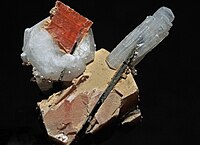
Photo from wikipedia
Protein modifications in liquid infant formula (IF) have been widely studied, but distinguishing between heat- and storage-induced structural changes remains challenging. A generic liquid IF was subjected to direct or… Click to show full abstract
Protein modifications in liquid infant formula (IF) have been widely studied, but distinguishing between heat- and storage-induced structural changes remains challenging. A generic liquid IF was subjected to direct or indirect UHT treatment and stored at 40 °C up to 180 days. Colour and pH were monitored and structural changes were characterised by dynamic light scattering, SDS-PAGE and centrifugal field-flow fractionation (FFF) coupled with multi-angle light scattering (MALS) and UV detectors to evaluate whether heat-induced differences would level out during storage. Both direct- and indirect UHT treatment led to structural changes, where the higher heat load of the indirect UHT treatment caused more pronounced changes. Indications were that storage-induced changes in pH, browning and non-reducible cross-links were not dependent on UHT treatment. However, FFF-MALS-UV analysis allowed characterisation of complex aggregates, where structural changes continued to be most pronounced in indirect UHT treated samples, and different storage-induced aggregation behaviour was observed.
Journal Title: Food chemistry
Year Published: 2021
Link to full text (if available)
Share on Social Media: Sign Up to like & get
recommendations!